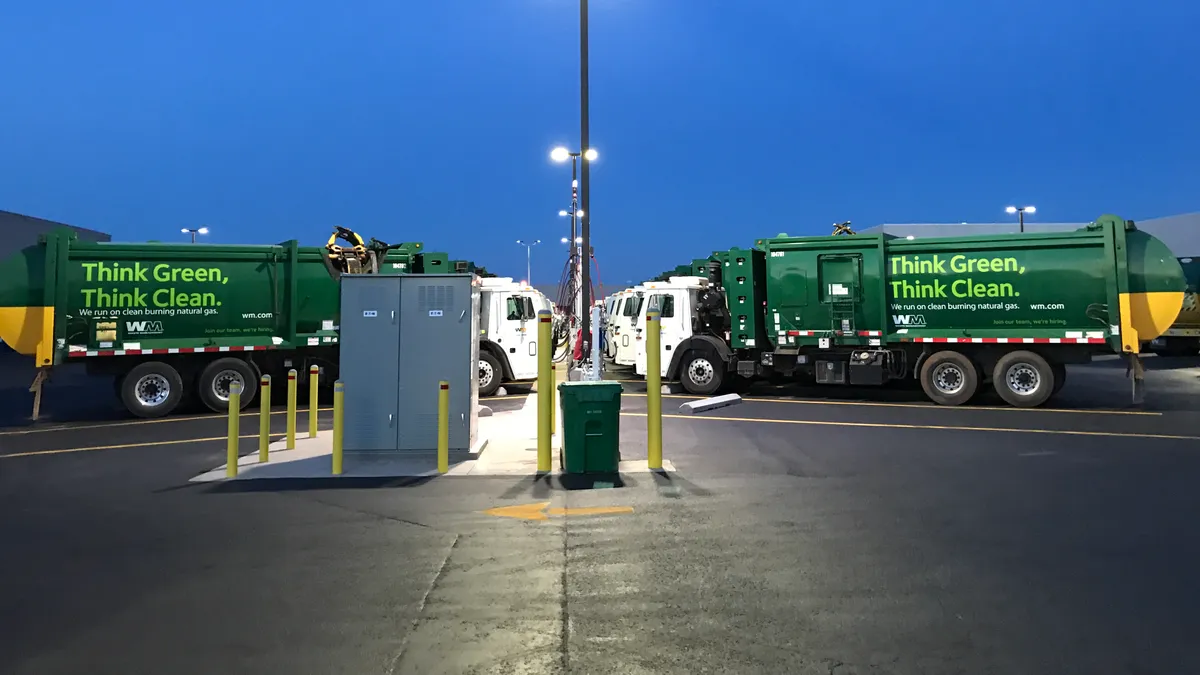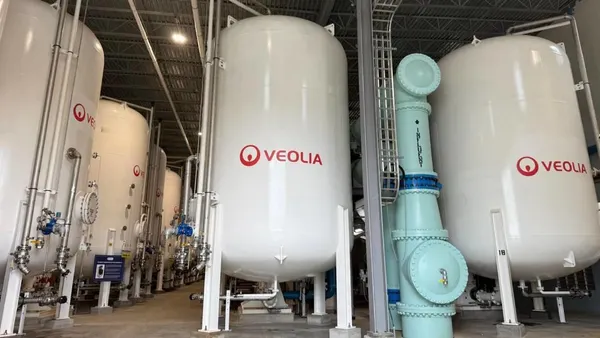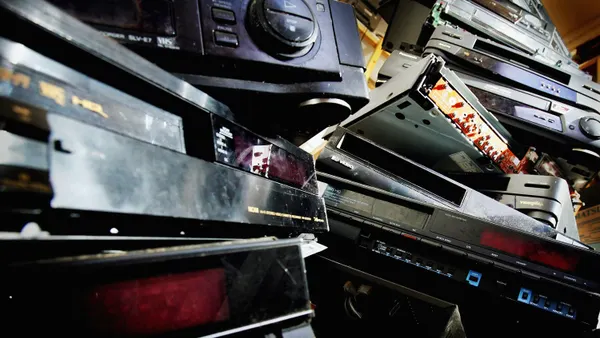Waste Management has long been one of the industry's more active companies when it comes to sustainability branding. Now, it's taking a new step by creating the first chief sustainability officer position among publicly traded waste and recycling companies.
Tara Hemmer started the job this month, after serving as senior vice president of operations in the southern half of North America and other positions since joining the company in 1999. She has played an increasingly visible role on the topic in recent years through hosting the company's annual sustainability forum, delivering a keynote on the climate "inflection point" at the 2020 Global Waste Management Summit and other industry events.
Hemmer now reports directly to Waste Management CEO Jim Fish and oversees the company's recycling, organics, renewable energy and sustainability policy teams. She enters the role in a period of increasing scrutiny around the contribution of landfill methane to climate change and growing interest in environmental, social and governance (ESG) plans from numerous stakeholders. Waste Management has also been speaking out more directly in favor of minimum recycled content laws and pledging a neutral approach on certain extended producer responsibility frameworks for packaging.
In a recent interview, Hemmer said she'll be thinking about many of these areas as "we build and evolve our broader ESG strategy." While the economics of certain alternatives will always be compared with disposal tip fees, Waste Management said it aims to expand related business lines based on policy drivers and customer preferences.
This conversation has been edited for length and clarity.
WASTE DIVE: What made it the right time for Waste Management to create this new role?
TARA HEMMER: Jim really was thoughtful about where we're headed as a company, and looking at those broader trends that we're seeing globally and certainly in North America. Sustainability for us is really a growth strategy. It's a growth lever at its heart.
We are an environmental solutions provider. I like to say we make living in cities and communities possible. The work that we do each and every day helps build vibrant communities. But at the end of the day, all of our customers and potential customers and governments and municipalities are going through some broader transitions – based on some themes that are out there that are well documented and talked about, like urbanization and the circular economy – and we touch all of those sectors. So there's an opportunity to really think through how can we help all of those stakeholders solve some of their problems and at the same time build our own business.
What should the industry be watching within the next few years to see the impact of this role and what it means for Waste Management?
HEMMER: We're roughly a $17 billion-revenue company. If you look at some of our sustainability business lines, like recycling and organics, it's roughly $1.5 to $2 billion in revenue. I think from a growth perspective, we would see that portion of our portfolio grow in response to some of these trends that we're seeing in the world today.
We're seeing them in North America with some of the organics legislation, certainly in California and other legislative frameworks throughout the United States. So it really is about that top-line growth, translating into how we're going to help our customers, how we're going to build that broader brand value when it comes to building the solutions that are going to be necessary to really ensure that our company is a leader in the future.
Is this going to mean shifting revenues out of other business lines like disposal, or do you think there's new business that is not being captured by Waste Management, or both?
HEMMER: I think it's definitely going to be a combination of both. There are four different categories that we're examining. One is, how are we going to build our core business based on our sustainability platform? So we've done a fantastic job, as an example, of growing our national accounts business because we have reporting platforms where we can help our customers with their sustainability needs on tracking much of the material that they manage.
Many customers view us as a sustainability leader, and that's important to them. So how can we grow that core business portfolio? How can we grow our traditional sustainability services offerings, which I just mentioned. How can we innovate with new products and service offerings that are going to respond to some of the trends? There are plenty of companies who have zero waste goals, and we have a leadership position in that space. Not just from a thought leadership perspective, with the work that we do at the Phoenix Open and other large events like that, but more tangible efforts related to the investments that we've made in some of our traditional recycling plants.
Then, where can we potentially look at markets that we may not be in in North America and use these sustainability platforms that we have today? So there's definitely the possibility, and I think California is a great example, where materials may shift from one way that they're managed – like landfills – to another way in the future.
There will also be a part of it where, at our heart, we're a transportation and logistics company, too. We move materials from point A to point B. So it's about really leveraging those unique strengths to ensure that we can grow.
On organics, it feels like the opinion of many people in the waste industry has been "we can do anything if the customers ask for it," but it's not necessarily something that can be scaled up absent a willingness to pay more or policy drivers. As Waste Management ramps up with customers for California's SB 1383 requirements, does that come with any new lessons or efficiencies to then go do it elsewhere, even if policy drivers aren't in place?
HEMMER: At least today, we're looking at where there are broader policy drivers and, ultimately, that's where we're making investments in more mid- to larger-scale organics infrastructure. California is an example of that, but we also have organics infrastructure through our CORe technology in New York and New Jersey and Boston – where there's also legislation and we also have customers who are willing to pay for the service.
Like anything, if you look at some of the broader trends in the world, technology is going to be something that will be an accelerant. There will be innovations in technology solutions that will come to bear that might lower the cost of organics processing. But for now, it definitely is squarely where customers are willing to pay for organics processing capability as a service and then just also being mindful of the lifecycle impact some of the policy decisions that might be made related to how organics are managed and handled. Because if you're sending three, four collection trucks down the street to service a customer, you have to look at that in concert with some of the other back-end management practices.
That does seem to be a trade-off with policies like 1383, looking at how much organic material will still go to disposal with a three-cart system. With your new Davis Street facility in San Leandro, spurred by a contract with Oakland, that seems to be an example of local government saying it wants to do source separation but also still sort the residual stream. Is that an approach you think could be scaled up, or is that a unique situation?
HEMMER: It's interesting, because if you look at the processing capabilities that we've built in California, and you're familiar with Davis Street, we also have our Sun Valley facility and we have a facility in Orange County, and they are very different.
I think the solution that you referenced in San Leandro is pretty unique, because it's basically looking at every aspect of material that is getting discarded and finding a way to take every ounce of potential value out of it. That comes at a significant cost, and in that example, our customer was willing to pay for it. I'm not sure that would be the case across the country or even in pockets of California. L.A., as an example, took a very different approach, and we have a fantastic technology there where we're taking organic material and basically leveraging some anaerobic digestion technology. So I think right now, we're looking at many different solutions, and it remains to be seen which will be the right solution.
I think there's also a little bit of a misnomer because not all streams are the same. So we're trying to look at different technologies for commercial versus residential versus multifamily, and really look at what makes the most sense. So I think we have a lot still to learn and we'll apply those key learnings to the next generation of technology that we deploy, not just in California, but throughout North America.
What could we see in the next few years in terms of the company's organics infrastructure investments? Waste Management already has a large composting network, but could the company ever build its own anaerobic digester or take another approach?
HEMMER: I think what we're doing right now is we're leveraging existing anaerobic digestion infrastructure. That's what we're doing with our CORe facilities is we're creating this slurry product that we then move to local wastewater treatment plants that have excess digester capacity. We're not having to invest in that digester capacity, we're leveraging capacity that already exists in the marketplace. So right now, we don't feel like we've had to do that. It really will depend on whether or not we can still access excess capacity, or if we feel like we need to build digester capacity based on the solutions that we're providing.
Turning to curbside recycling, part of the company's sustainability goals is reducing contamination and increasing tonnage. What do you think is the lever to see the next wave of exponential growth on quality recycling tonnage?
HEMMER: If you look at what's happening right now with some of the pricing dynamics, in particular on plastic, what we're seeing is that the demand is there. If you look at what's happening with prices for HDPE natural around $1 a pound, or $2,000 a ton, higher than aluminum, that's unheard of. It's because there's really strong demand on the back end for recycled content. That was not true two years ago, it's happened very swiftly. So there is a need for broader supply.
Generating supply is a little bit of a challenge, because at the end of the day a portion of it is education. There's been a lot of changes in the recycling space on what you can and can't put in the bin. So we've tried to be very proactive in our communications with municipalities to make sure that they understand and their residents understand the types of materials that can be put in as the stream is evolving.
A great example of that is several years ago, yogurt containers might have been made out of a seven plastic, which has little to no value. The packaging industry made some changes, and today they're made out of No. five polypropylene, and that has strong value, and there are markets for it.
On the municipal side, we still in North America have many municipalities who don't offer recycling as a service, or people who have smaller recycling containers than they do their traditional waste container. Those are individual municipal decisions, often that are made based on budgetary constraints or other policy issues, and that's a bigger issue to tackle.
One area we're hearing more about is that even if recycling can be maximized, there's also desire for more waste reduction and reuse and refill programs – especially when it comes to plastics. Theoretically, a reduction in tonnage could be considered a problem for your business model. What does this mean for Waste Management?
HEMMER: I think it's interesting, and I'll use lightweighting as an example. When many of the brands started using less material per water bottle, I think initially that might have had a little bit of a blip in our business, but we adapted. And I don't think we necessarily think of ourselves as "we want to aggregate the most material." I think we view ourselves as a solutions provider.
So we can build our revenue streams around being that solutions partner, and providing solutions to our customers that will help them think through these things. An example of that is, we have a group called WM Sustainability Services that goes into many manufacturing plants and helps them with their broader waste-reduction goals. You would think, well, that's counterintuitive, don't you want more of the material going to your facilities? What we ultimately want to do is create broader customer value, and if we have that strong value proposition, we'll be able to grow our business. That really speaks to all of our lines of businesses. We recognize that our business model has to adapt with our changing customer needs.
While a number of landfills already have gas-to-energy plants in place, it feels like we're reaching a new generation of technology and business models, coupled with regulatory pressure. What new opportunity do you seen on that side of the business?
HEMMER: We've been a leader in the renewable natural gas space. We have 14 facilities on our landfills that we have third-party relationships with, and then we've built some for ourselves; they've been quite successful. We have a pipeline of around 16 to 20 other plants that could be built, and we're actively and pretty aggressively marching down a path to figure out how fast we can build them.
The catalyst, if you think about what might have existed maybe two or three years ago, is that there's certainty, or a little more certainty, related to some of the regulatory frameworks – in particular, RFS2 and the RIN program – which make these programs a little less volatile. That puts everyone in a position, and ourselves included, to really think about these significant investments.
These are a great example of how we can close the loop at our facilities, and especially for WM, given that we have the largest fleet of natural gas vehicles in North America. We convert [landfill gas] to renewable natural gas, and that renewable natural gas could end up powering one of our trucks that ultimately shows up at your home. Certainly, when you think about the focus on renewables and the energy transition that the Biden administration is committed to, we think renewable natural gas is a great example of how we can play in that space.
What should we expect see from Waste Management in the evolving discussion around landfill emissions? The EPA thinks they're being underestimated; the industry says they're being overestimated. In the next few years will there be even more clarity on the true role of landfills in contributing to climate change?
HEMMER: If you look at the 2025 goals that we set, we want to have accurate measurements of our fugitive emissions. We definitely think they could be overestimated based on the modeling, and we think it benefits everyone to have accurate measurements instead of using the modeling, which is the best tool that we have today. So we've been investing in that and looking at satellite technology and making sure that the satellite technology and how it's used appropriately looks at our emissions.
So we think that that's an opportunity for us and the industry in particular. I think the other thing that often gets lost in translation for WM is that we have made significant progress on the emissions that we report. A lot of that has to do with the fact that we continue to make investments in gas infrastructure and capping at our landfills and making sure that we have really strong management practices that make us a good community partner. So we definitely think that technology, and innovations related to technology, are going to take us to a place where we will be able to measure the emissions at our landfills, and it'll help with broader practices going forward.
Ten years from now, what do you think looks substantially different for the North American waste industry on the sustainability front?
HEMMER: We know very definitively that our customers' preferences are changing based on social and environmental impacts, that customers are paying more for sustainable products. Employees are definitely much more focused on working for environmentally and socially responsible companies. There's broader government regulation, certainly, around the the transition to a net zero economy globally and in North America. So when you marry all of these together, there are going to be these more robust solutions that are going to be built to turn materials into their next best life, probably in a more aggressive way than we're seeing today.
I think we're seeing recycling and our investments in recycling, where we've been very intentional, really pay off. We're able to be a bit more nimble as markets evolve. So I definitely think that if you were to look at the portfolio of collection, transfer, landfill and recycling, and what that looks like today, I think some of the more nontraditional business lines will probably be a bigger piece of the pie, and there might be different solutions that we hadn't thought about today that will exist in the future.











